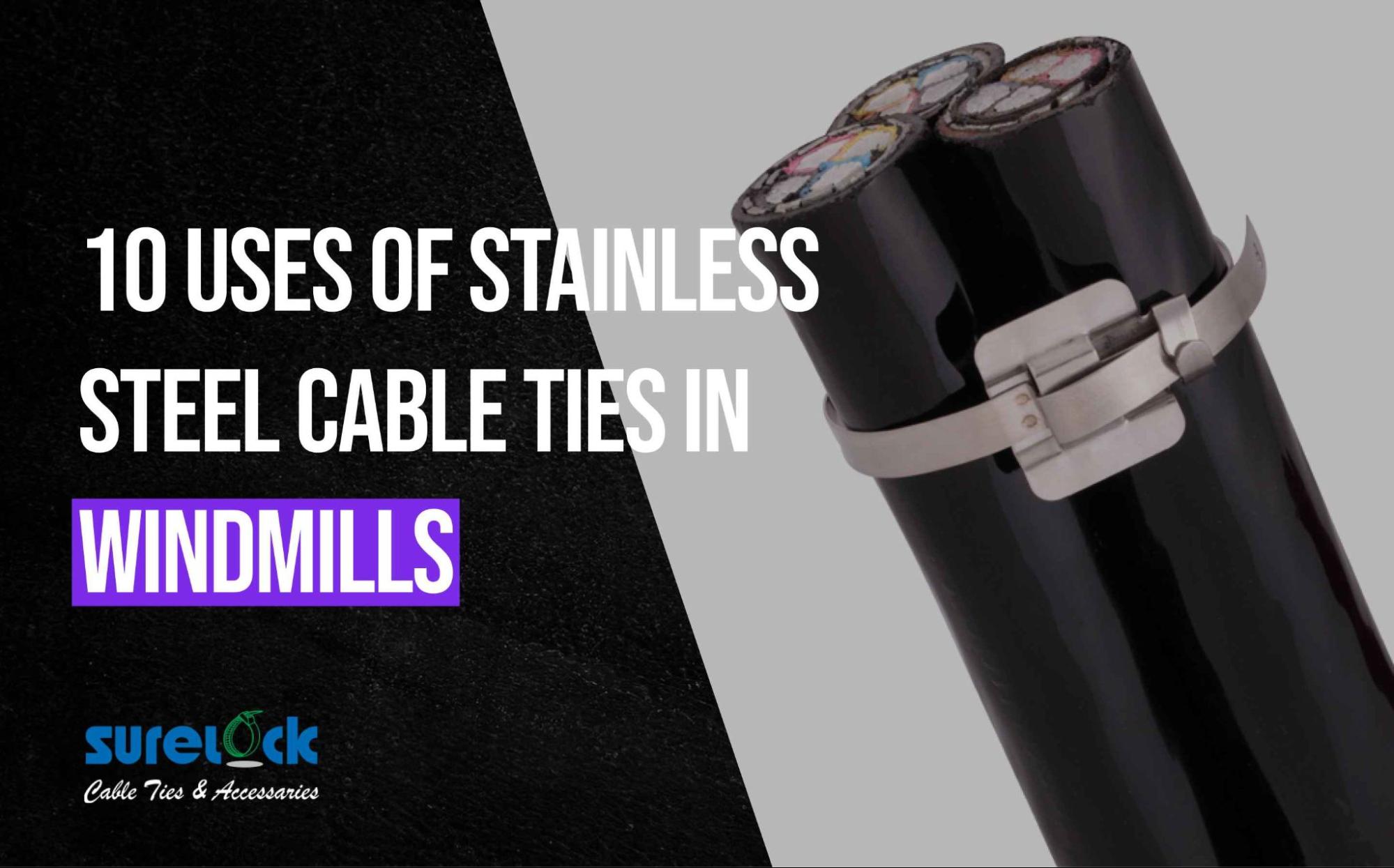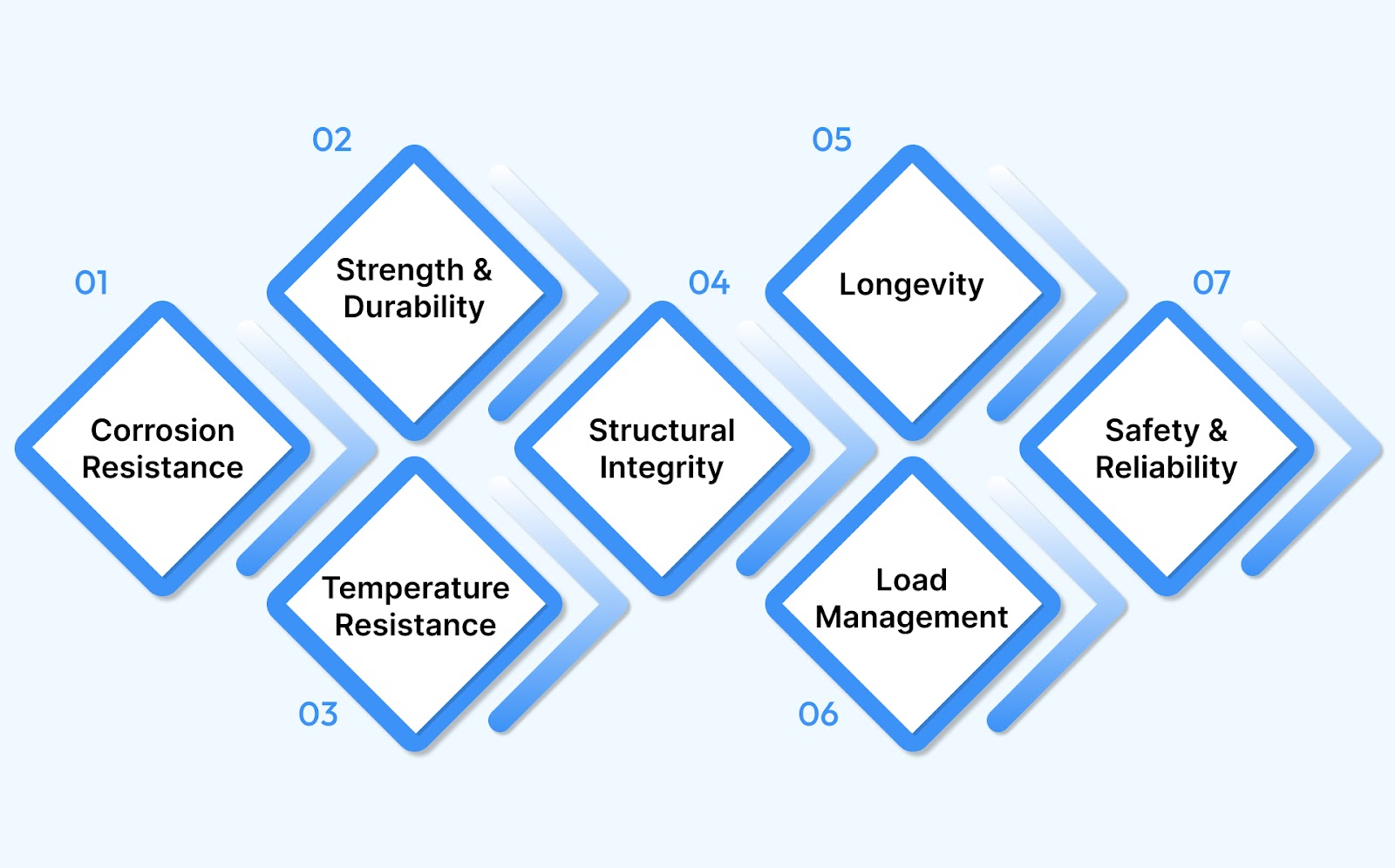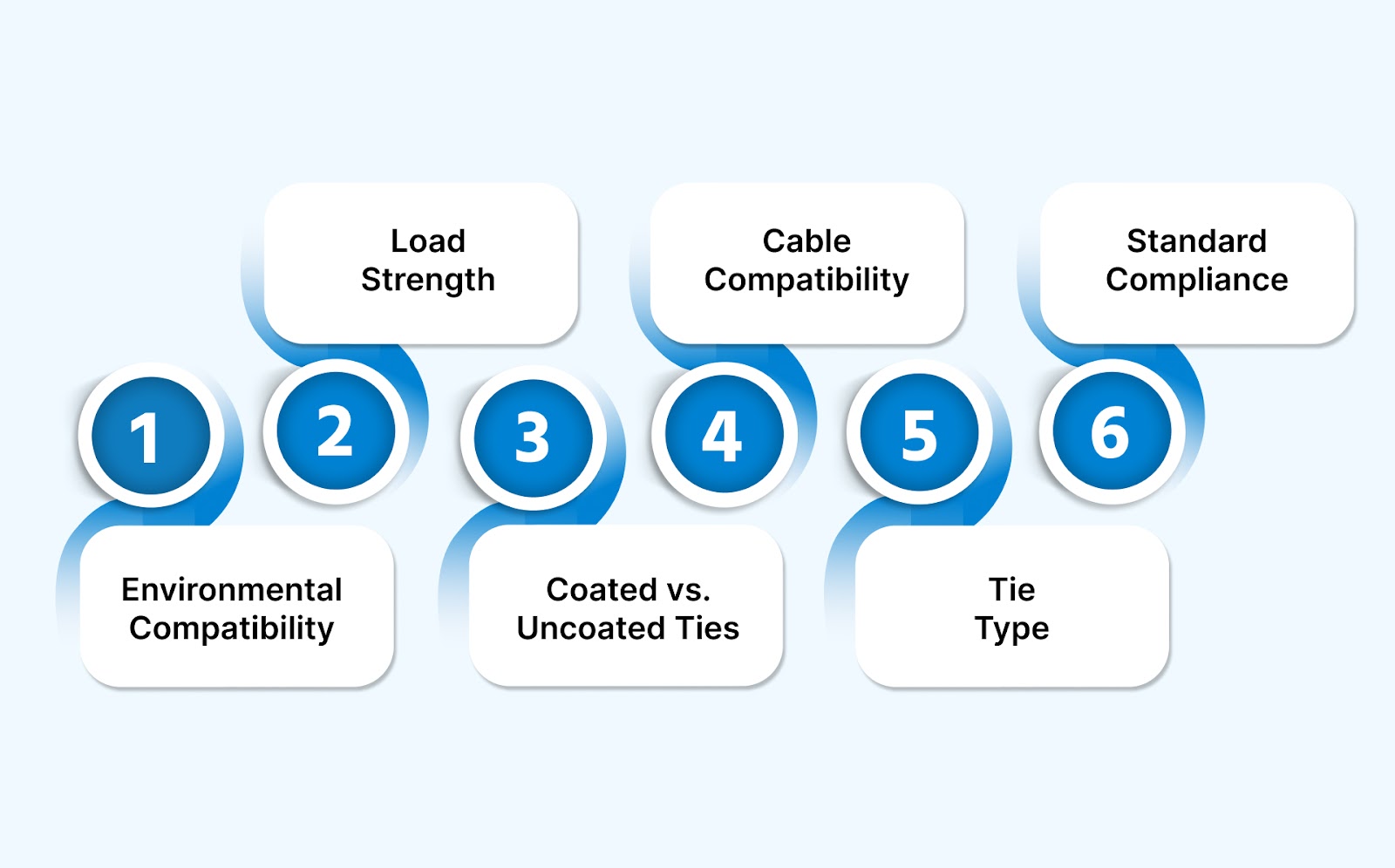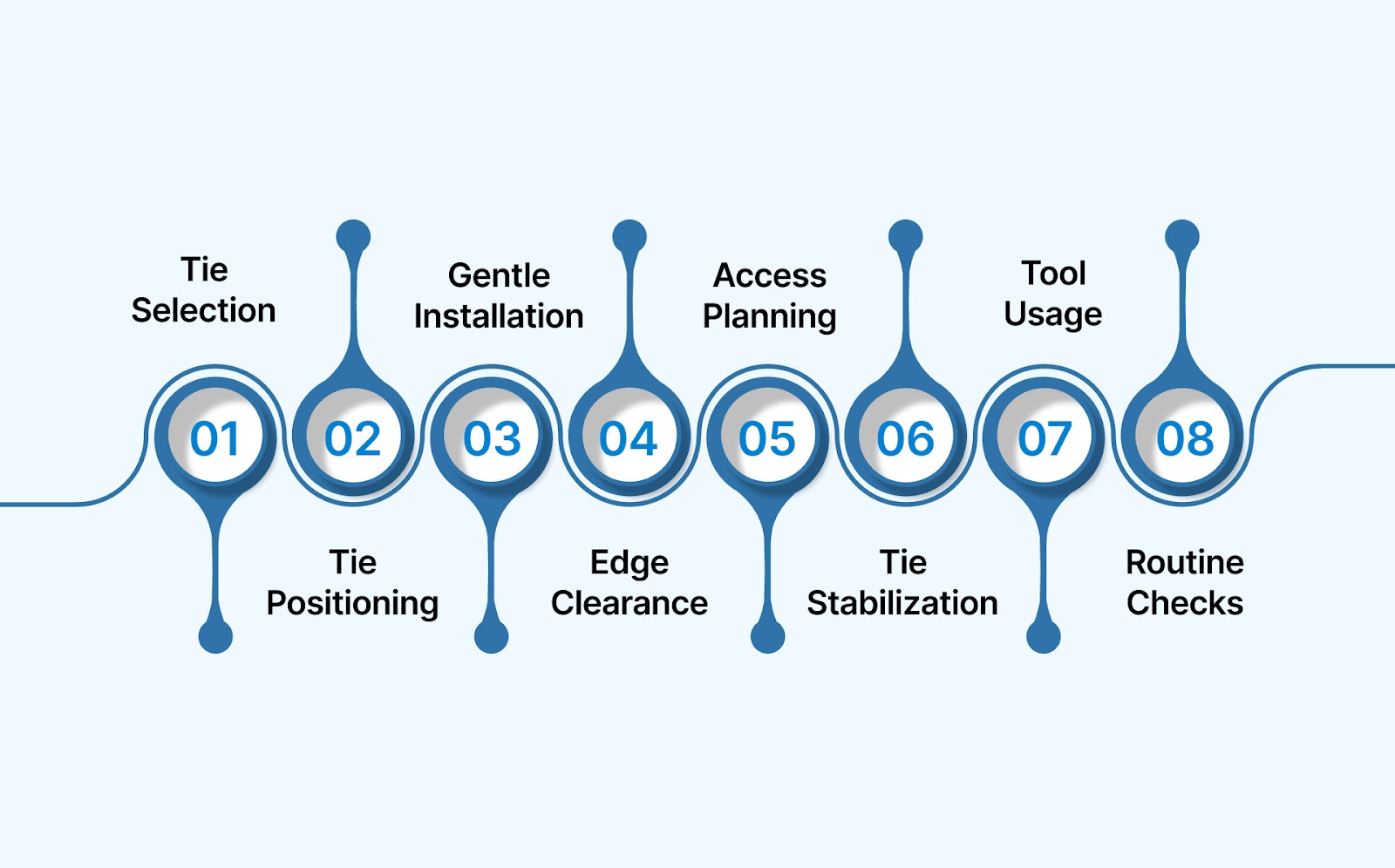10 Uses of Stainless Steel Cable Ties in Windmills
August 1, 2025

How do you secure and organize cables in windmills, ensuring they withstand harsh winds, vibrations, and extreme weather conditions? Windmills are among the most efficient and sustainable energy sources. Still, their components face relentless challenges in the form of extreme weather, vibrations, and exposure to UV rays, salt, and moisture.
One critical aspect of windmill functionality is the management of cables that carry power and data signals. If these cables are not properly secured, they can suffer damage, affecting the performance and longevity of the entire system.
This is where stainless steel cable ties come into play. Known for their strength, durability, and resistance to corrosion, SS cable ties are an essential tool for securing cables in windmills.
In this blog, we’ll explore the uses of SS cable ties in windmills, their benefits, key features, and the various types available to help you understand why SS cable ties are critical for both system reliability and efficiency.
What are Stainless Steel Cable Ties?
Stainless steel cable ties are robust fastening solutions made from high-quality stainless steel. They are designed to secure cables and wires in place. Unlike traditional nylon ties, these metal cable ties provide exceptional strength and resistance, making them ideal for challenging environments.
With their corrosion-resistant properties, stainless steel cable ties can withstand exposure to harsh weather conditions, saltwater, and UV radiation, ensuring long-lasting performance. Their design allows them to handle high tension, preventing cables from sagging or moving due to vibrations or extreme wind forces.
Understanding the core attributes of these ties sets the stage for diving into their critical advantages in windmill systems.
Benefits of Using Stainless Steel Cable Ties in Windmills

Windmills, especially those installed in offshore locations, face some of the harshest environmental conditions. With extreme weather, constant vibration from turbine operation, exposure to UV radiation, and salt and humidity in the air, these systems are constantly tested.
In such environments, ensuring the cables remain secure, organized, and unaffected by these conditions is critical to maintaining optimal performance and safety. Stainless steel cable ties provide the perfect solution. Here are the benefits they provide:
- Corrosion Resistance: Stainless steel cable ties are highly corrosion-resistant, making them especially suitable for coastal and offshore windmills where saltwater exposure accelerates degradation.
- High Strength and Durability: Engineered for high tensile strength, these ties can withstand significant mechanical stress, vibrations, and dynamic loads typical in wind turbine operations.
- Temperature Resistance: Stainless steel ties excel in extreme temperatures, providing reliable performance even in freezing or high-heat climates.
- Structural Integrity: Stainless steel cable ties help maintain the windmill system's overall structural integrity by securing cables and maintaining their position.
- Longevity: With stainless steel’s long lifespan, maintenance and replacement cycles are reduced, offering long-term savings in operational costs. This contributes to improved efficiency and reliability.
- Load Management: Stainless steel cable ties effectively manage heavy power and control cables, preventing sagging or shifting that could otherwise lead to mechanical failure or damage.
- Safety and Reliability: Stainless steel cable ties enhance the windmill's overall safety and reliability by securing power cables and attaching emergency system wiring.
These capabilities make stainless steel cable ties crucial to windmills' efficient and safe operation. Now, let's explore the practical roles these cable ties play in maintaining windmill efficiency and integrity.
Also read: How Long Do Cable Ties Last Outside? A Comprehensive Guide
10 Uses of Stainless Steel Cable Ties in Windmills

Stainless steel cable ties play a vital role in maintaining the integrity and performance of windmills by providing secure cable management solutions that withstand the harsh conditions found in wind energy systems.
Below are 10 key uses of stainless steel cable ties in windmills, ensuring the optimal performance and longevity of turbine components.
- Securing Power Cables in Turbine Towers: Stainless steel cable ties help prevent power cables from sagging or being damaged by vibrations and movements in the turbine tower. This ensures that cables remain securely in place, minimizing risks of disconnections or wear over time.
- Bundling Data and Control Cables: By neatly bundling data and control cables, stainless steel ties ensure reliable signal transmission for monitoring and automation systems. This organization prevents tangling and reduces the chance of interference, ensuring smooth operational functionality.
- Fastening Lighting System Wiring: In the nacelle and tower, stainless steel cable ties secure lighting system cables while withstanding high temperatures and UV exposure. Their durability ensures that the lighting system remains operational, even in extreme weather conditions.
- Fixing Weather Monitoring Equipment Cables: Weather monitoring equipment is crucial for windmill performance, and stainless steel cable ties protect sensor wiring from wind, moisture, and salt spray, particularly at high altitudes. This ensures that weather data remains accurate and reliable for turbine adjustments.
- Supporting High Voltage (HV) Cable Runs: For heavy HV cables, stainless steel cable ties provide robust support, preventing cable movement or sagging. This enhances the safety and longevity of the high-voltage system, ensuring that the windmill’s electrical infrastructure remains secure and efficient.
- Attaching Cable Tags and Identification Markers: Stainless steel cable ties can be used to attach tags and identification markers to cables, making tracking and maintaining the system easier. This simple yet effective solution helps technicians locate and identify specific cables during routine inspections or maintenance.
- Securing Emergency System Wiring: Emergency shutdown systems and alarm cables require secure, heat-resistant fastening. Stainless steel cable ties ensure that these critical safety components remain intact and functional, even under high heat or emergency conditions.
- Organizing Internal Control Panel Wiring: Inside the control cabinets of windmills, stainless steel cable ties help maintain neat and organized wiring. This ensures easy access to wires for troubleshooting, reduces clutter, and supports the overall efficiency of the control panel system.
- Fixing External Communication Cables: External communication cables are exposed to harsh outdoor conditions like wind, rain, and UV radiation. With their corrosion resistance and strength, stainless steel cable ties provide reliable protection and secure fastening, ensuring communication systems function without interruptions.
- Temporary Repairs and Maintenance Tasks: During routine or emergency maintenance, stainless steel cable ties serve as a quick and reliable solution for temporary repairs. Their easy application and durability allow technicians to secure cables and systems until more permanent repairs can be made.
Ensure lasting performance in your windmill systems with Surelock's high-quality stainless steel cable ties. Discover how our solutions can support your power cables, communication systems, and more.
With a clear understanding of how these ties work, it’s important to know which types are designed explicitly for windmill applications.
Types of SS Cable Ties in Windmills
Various types of stainless steel cable ties are designed to meet the specific needs of wind energy applications, offering superior resistance to harsh environmental conditions. Below are the types of stainless steel cable ties used in windmills to ensure optimal performance across a range of applications:
- Reusable Steel Tie Coated: Designed for corrosive climates and high-temperature and tensile strength applications, these ties offer quick fastening of cables, tubes, and pipes and can be unfastened. The coating material is non-toxic, halogen-free, and UV-resistant, ensuring long-term durability in harsh conditions.
- Reusable Steel Tie Uncoated: Ideal for corrosive climates and high-temperature, high-tensile applications. These ties provide quick fastening and can be unfastened. They accommodate double wraps, and the smooth edges ensure safety during installation.
- Easy Lock Steel Tie Coated: These self-locking ties are perfect for corrosive climates and high-temperature, high-tensile applications. They feature multiple locking systems for fast, strong, and secure installation. The non-toxic, halogen-free, UV-resistant coating provides long-term performance in tough conditions.
- Easy Lock Steel Tie Uncoated: Made for corrosive climates and high-temperature, high-tensile applications, these self-locking ties feature multiple locking systems for fast and secure installation. Smooth edges ensure safety during installation.
- Multi-Lock Steel Tie Coated: Designed for corrosive climates and high-temperature, high-tensile requirements, these self-locking ties feature multiple locking systems for a strong and secure hold. The coating is non-toxic, halogen-free, low-smoke, and UV-resistant, ensuring longevity in tough environments.
- Multi-Lock Steel Tie Uncoated: These self-locking ties are perfect for corrosive climates and high-temperature, high-tensile applications. They have multiple locking systems for a secure hold, are designed to accommodate double wraps, and feature smooth edges for safety during installation.
- Ball Lock Steel Tie Coated: Ideal for corrosive climates and high-temperature, high-tensile requirements, these self-locking ties are easy to install. The ball inside the angled ramp ensures positive locking. The coating is non-toxic, halogen-free, low-smoke, and UV-resistant, offering durability in harsh conditions.
- Ball Lock Steel Tie Partly Coated: Suitable for corrosive climates and high-temperature, high-tensile applications, these self-locking ties are fast and easy to install. The ball inside the angled ramp ensures secure locking. The coating is non-toxic, halogen-free, low-smoke, and UV-resistant, providing long-lasting performance.
- Ball Lock Steel Tie Uncoated: Designed for corrosive climates and high-temperature, high-tensile applications, these self-locking ties are easy to install. The ball inside the angled ramp of the head ensures positive locking, and the smooth edges ensure safety during installation.
- Reusable Economy Steel Tie Coated: These ties are designed for low-cost, low-tensile applications. The coating is non-toxic, halogen-free, low-smoke, and UV-resistant, ensuring a long service life in harsh environments. Smooth edges provide safety during installation.
- Reusable Economy Steel Tie Uncoated: These ties are suitable for corrosive climates and high-temperature, high-tensile applications. They are designed for low-cost, low-tensile use and feature smooth edges for safety during installation.
Need the perfect stainless steel cable tie for your windmill? Surelock offers a range of durable, coated, and uncoated options tailored to wind energy applications. Explore our versatile tie types to find the best match for your project.
After identifying the types, it’s essential to know how to choose the best ones for your windmill to ensure optimal performance.
Choosing the Right SS Ties for Windmill Applications

Selecting the correct stainless steel cable ties for windmills ensures reliable and long-lasting performance. Given the harsh conditions wind turbines face, choosing the right cable tie ensures the security and efficiency of the entire system. Below are the key considerations to keep in mind when selecting stainless steel cable ties for windmill applications:
- Consider Environmental Conditions: Ensure the cable ties are suitable for the specific environmental challenges of your windmill installation. For offshore or coastal windmills, opt for ties that can withstand high humidity and sunlight exposure.
- Strength and Load-Bearing Capacity: Choose ties that offer the required tensile strength to manage the load from power cables, control systems, and other wiring. High-strength ties ensure that cables remain securely in place, even under the stress of high winds and mechanical vibrations.
- Coated vs. Uncoated Ties: For maximum durability, coated ties are ideal for maximum durability as they provide additional corrosion protection. Uncoated ties, while slightly less resistant to the elements, are still suitable for less exposed applications.
- Size and Fit for Cable Runs: Ensure the selected ties are appropriate for the cables you manage. Choose ties that offer flexibility, allowing them to securely fit cables of various sizes and simplify installation.
- Reusable vs. Single-Use Ties: Depending on your needs, choose between reusable and single-use cable ties. Reusable ties are perfect for maintenance tasks where adjustments or repairs are frequently needed, while disposable ties work best for permanent installations.
- Compliance with Standards: Make sure the selected cable ties meet relevant industry standards and certifications, such as ISO 9001:2015 (International Organization for Standardization 9001:2015) for quality management. These certifications ensure their reliability and safety in wind energy applications, contributing to the overall integrity of the windmill’s wiring system.
By carefully considering these factors, you can ensure that the stainless steel cable ties you choose will effectively support the functionality and durability of your windmill, reducing downtime and increasing the system's longevity.
Once you've selected the right cable tie, proper installation is key to maximizing its effectiveness in windmill systems.
Also read: How to Easily Cut Metal Cable Ties?
Proper Installation of SS Cable Ties in Windmills

The installation of stainless steel cable ties in windmills is a critical step in ensuring the secure and long-lasting operation of your wind energy system. Proper installation keeps the wiring system organized and enhances the wind turbine's overall structural integrity. Here are some essential tips for installing stainless steel cable ties to ensure optimal performance and durability:
- Choose the Right Tie for the Job: Select the appropriate stainless steel cable tie based on the environmental conditions and load requirements. Ensure the tie is strong enough to handle the environmental stress factors of the windmill.
- Ensure Correct Tie Placement: Position the cable ties at intervals that are close enough to hold the cables securely but not too tight to cause damage. Use multiple ties to distribute the load evenly for large cable runs, preventing sagging or strain on individual ties.
- Install Without Over-Tightening: While it’s important to secure cables properly, over-tightening can cause stress on both the tie and the cables. Apply just enough pressure to keep the cables in place without damaging the insulation or the cable itself.
- Avoid Contact with Sharp Edges: When securing cables near sharp edges or surfaces, ensure the cable ties are installed with proper protection to avoid cutting into the cables. Use protective sleeves or additional clips where necessary.
- Check for Accessibility and Maintenance: Install the cable ties to allow easy access for future inspections or maintenance. Cables should be organized and clearly identifiable, so maintenance teams can quickly address any issues.
- Position Ties to Avoid Movement: For windmill installations subjected to extreme winds and vibrations, ensure the cable ties are positioned to prevent movement or slack. This will help reduce wear and tear over time, extending the life of the cables.
- Use Proper Tools for Installation: For consistent tension and a secure hold, use the proper tools designed for installing stainless steel cable ties, such as a tensioning tool or cable tie cutter. This ensures that the ties are evenly tightened without the risk of damage.
- Perform Regular Inspections: After installation, regularly inspect the cable ties to ensure they hold the cables securely and show no signs of corrosion or wear. Timely replacement of damaged ties prevents costly repairs in the future.
By following these tips, you can ensure a well-organized, secure, and long-lasting cable management system for your windmill, improving both safety and performance.
Conclusion
Durability, corrosion resistance, and structural integrity are crucial in wind energy. Stainless steel cable ties play a pivotal role in ensuring the reliability of windmill systems. Their superior strength makes them ideal for withstanding extreme weather, vibrations, and harsh conditions found both onshore and offshore.
These ties are essential in keeping wind energy systems running smoothly for years by securing cables, organizing wiring, and protecting sensitive equipment.
Surelock understands the unique challenges in windmill applications and provides an extensive range of high-quality stainless steel cable ties, designed for durability and performance. From metal tooth ties to reusable steel ties, our solutions offer unmatched strength and resistance.
Contact us now to learn more about our products and how we can help secure your wind energy projects.



